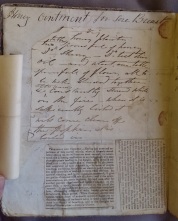On this Mother’s Day I find myself in Dublin, embarking upon the archival phase of research for my Centre for the History of Emotions project, ‘Mother’s Milk: Breastfeeding, Infant Care and Domestic Medicine in Early Modern Ireland.’ I am lucky enough to be able to spend the next few weeks ensconced in the National Library of Ireland, absorbed by their collection of manuscript receipt (recipe) books.

I first encountered these fascinating sources when I was just starting my doctorate. Back then I was interested in their cookery recipes, and although I occasionally stopped to cast my eye over the equally rich collection of prescriptions and cures they contain, for the most part I rushed over them, my thesis on food history requiring complete devotion. I remember, at the time, being somewhat curious as to why everyone needed cures for ‘Sore Breasts’ in the eighteenth century (how naïve I was), but I didn’t think much more of it- the quest to find the earliest potato recipe seeming much more important. Three babies later, I now understand what all the fuss was about. The need for a cure for sore breasts, advice regarding milk supply and a remedy for colic, have since become very real. So, with three wee boys in tow, I am back to explore these tomes of early modern wisdom, with a very different set of (somewhat sleep-deprived) eyes.

Domestic sources like manuscript receipt books give us an intimate window into the lives and concerns of women in the early modern world. They contain a rich variety of materials, including cookery recipes, medical cures, housekeeping advice, beauty remedies, meal plans, prose and poetry, which collectively provide us with a highly detailed account of life within the early modern home. The unique contents of each volume can also help us to understand the everyday concerns of individuals in a degree of detail which is quite rare. One volume I was examining just this week contained at least a dozen cures for baldness in men, and the image of a wife consulting her collection of cures gathered from far and wide, while a concerned husband fretting over his receding hairline hovers anxiously in the background is conjured vividly (National Library of Ireland, Ms 42,009).

One of the most striking features of early modern receipt books is the fact that they bear the creative input of people from a wide social circle, and were clearly a place in which familial and kinship knowledge, legacy and networks were maintained. Through attributions, which respectfully acknowledge the original source of an entry, we are able to see how women shared knowledge relating to the care of their families. Letters containing cures and recipes are also frequent components of domestic collections, demonstrating how women bridged geographical distances and maintained an active involvement in the care and nourishment of one another and their children. Generational divides could also be overcome through these manuscripts. If we look closely at the lifecycle of an individual book, we can see that many of these volumes became family heirlooms, handed down from one generation of women to the next. As cherished items of property, bequeathing a receipt book to a daughter or daughter-in-law was both a sign of affection, but it was also a gift of invaluable practical knowledge. Given the wealth of information they contain relating to domestic medicine, which was gathered over generations, it was also a gift that could provide critical to the health and well-being of the family in the future.
The volumes contain a range of cures and prescriptions for a host of illnesses from every day complaints such as worms and rheumatism to far more serious conditions including cancer and rabies. Given their importance in the sphere of domestic medicine, and their association with women as their primary authors and custodians, it is unsurprising that these manuscripts also contain extensive advice relating to reproductive health [Fig.1 to 2], breastfeeding and infant and child care [Fig. 3 to 4].
![Fig. 4 ‘Receipt for Children ill with Hives’. From the receipt book of Lady Elizabeth Maguir[e], NLI Ms 42,228, mid- to late eighteenth century (courtesy of the National Library of Ireland).](https://historiesofemotion.com/wp-content/uploads/2015/05/fig-4-jpg.jpeg?w=150&h=111)

Sometimes as historians we are astounded by how much has changed, but at other times, we can be touched by just how much in the human experience stays the same. The other day, upon returning home from the archives to a hungry baby, I emailed my sister back in Australia to ask when she introduced solids. I then checked the advice of a breastfeeding forum on Facebook I regularly use, to see what other mothers had to say on the subject. The medium for sharing information may now be email, text or social media, and technology may have rapidly expanded the scope of our networks, but the essence of the practice is still very much the same- women circulating knowledge and assisting one another in the care of their bodies and babies.
This symmetry of experience became even more apparent the following day, as the afternoon wore on and the risks of missing several feeds seemed to be catching up with me. I was struck immediately by the irony of the fact that a research project about cures for breastfeeding ailments had in fact led to my own predicament, but my own dull ache also gave me a very real and immediate sense of connection to the late eighteenth-century woman whose advice for ‘sore breasts’ I was hurriedly transcribing (NLI Ms 14,901).

She recommended a concoction of white wine, olive oil and flour spread on leather and applied to the afflicted breast, sound advice I am sure, but instead I opted for cabbage leaves and some paracetamol on the way home, my own mum’s orders, and after all, she knows best.
By CHE Associate Investigator Madeline Shanahan.
